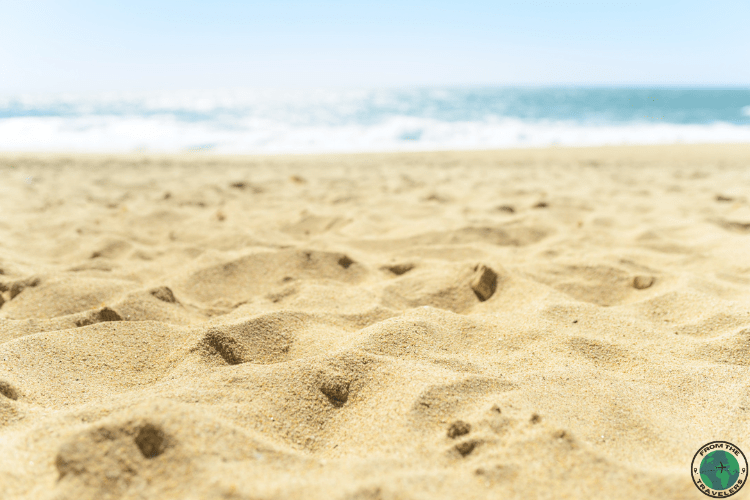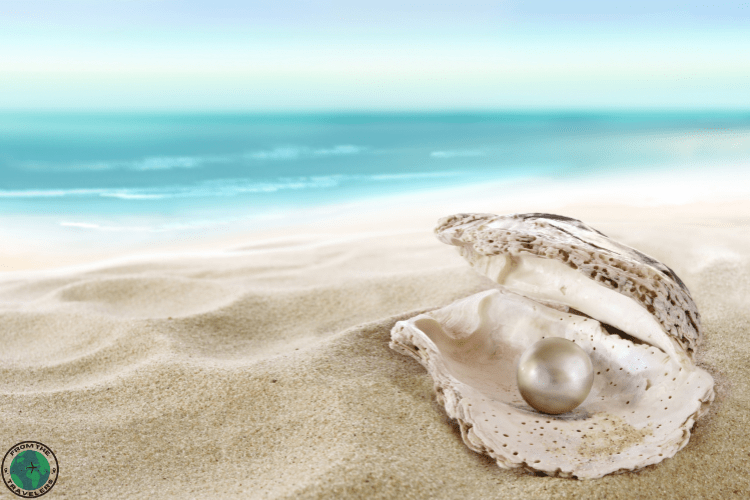When we imagine a beach, the first thing that comes to mind is the soft, powdery white sand under our feet. But have you ever thought about what makes that sand so exceptional? In this article, we will reveal the beauty and magic behind white beach sand. Pearl beach sand is not just usual sand; it consists of small fragments of shells, corals and other marine organisms. These minuscule particles have been polished and shaped over time by the forces of nature, making a stunning white colour that contrasts with the vibrant blue of the ocean.
The purity of white sand beach is not only visually tempting but also has numerous benefits. Its fine texture makes it a pleasure to walk on and build sandcastles with. In addition to this, it works as a natural exfoliant, lightly scrubbing away dead skin cells as you stroll along the shore. Join us as we dive deeper into the science behind snowy beach sand and explore the fascinating processes that contribute to its compelling beauty. Get ready to be captivated by the magic hiding under your toes on your next beach vacation.
Formation Of White Sandy Beach
White sandy beaches form through the gradual breakdown of minerals and rocks over time. The process starts with the weathering of rocks, where wind, water, and temperature changes contribute to the breakdown of particles. These particles are then taken by rivers or ocean currents to coastal areas. The continuous motion of waves further grinds down these particles, creating fine-grained sand. The white colour usually comes from the presence of quartz and other light-coloured minerals in the rocks. Over millions of years, this natural cycle of breakdown and sedimentation shapes pleasing white sandy beaches that fascinate visitors worldwide, depicting the beauty of Earth’s geological processes.

Types Of Ivory Beach Sand
Ivory beach sand typically refers to a type of beach sand that has a pale, off-white or cream colour like the hue of ivory. The colour is usually influenced by the minerals and elements present in the sand. While the term ivory beach sand is not a scientific classification, variations in composition and manifestation can occur based on the location and geological factors. Diverse coastal areas may have sands with unique characteristics, but they usually fall under the broader category of light-coloured, ivory-like beach sands. The specific types and changes may include quartz-rich sands, carbonate sands or mixtures with other minerals found in the region.
Quartz Sand:
Generally found in various white sandy beaches, quartz is a hard and durable mineral that contributes to the bright colour of the sand.
Calcite Sand:
Composed of calcium carbonate, calcite sand is another type usually found in white beaches, particularly in areas with limestone formations.
Gypsum Sand:
In some coastal regions, gypsum, a soft sulfate mineral, can contribute to the formation of white sandy beaches.
Shell Sand:
Crushed shells, normally from marine organisms like clams or corals, can make white sandy beaches in areas with plentiful shell debris.
Limestone Sand:
Beaches near limestone-rich geological formations may have white sand consisting of fragments of this sedimentary rock.
Feldspar Sand:
White sand with a slightly pink or tan hue may include feldspar minerals, adding a subtle colour variation.
Mica Sand:
Mica, a shiny mineral, can contribute to the sparkle in some white sandy beaches.
Volcanic Ash Sand:
In regions with volcanic activity, white sandy beaches can form from the weathering of volcanic ash, which usually contains light-coloured minerals.
Granite Sand:
Beaches close to granite formations may have white sand composed of weathered granite particles.
Garnet Sand:
In a few cases, beaches may have white sand with a pinkish tint due to the presence of garnet minerals.
Environmental Impact Of Crystal Beach Sand Mining
Crystal beach sand mining can have adverse environmental consequences. Extraction disturbs coastal ecosystems, leading to habitat loss for marine and terrestrial species. The process changes sediment dynamics, affecting shoreline stability and increasing erosion risks. Furthermore, mining operations can contaminate surrounding water with sediments and upset the delicate balance of coastal ecosystems. Sand mining contributes to the depletion of natural resources, affecting biodiversity and threatening rare species. The removal of sand can also worsen the effects of climate change by minimizing the natural buffer against storm surges. Sustainable practices and regulations are necessary to reduce these environmental effects and secure fragile coastal ecosystems.
Properties And Characteristics Of Snowy Beach Sand
Snowy beach sand usually linked with pristine and light-colored shorelines has distinct properties and characteristics.
- Colour: The defining feature of snowy beach sand is its bright white or pale colour, resembling the pristine look of snow.
- Composition: Snowy beach sand is usually composed of fine-grained minerals such as quartz, feldspar, and most times calcite. The dominance of these light-coloured minerals contributes to the sand’s snowy look.
- Texture: The sand is typically fine and soft, providing a comfortable and inviting surface for beachgoers.
- Reflectivity: Snowy beach sand has high reflectivity, meaning it reflects sunlight well. This can create a dazzling and visually appealing environment.
- Coolness: Due to its light colour, snowy beach sand tries to stay cooler than darker sands, making it easier to walk on during hot weather.
- Origin: The sand’s snowy colour may be the consequence of the erosion of light-coloured rocks, such as quartz-rich granites or other minerals found in the surrounding geological formations.
- Purity: Snowy beach sand is usually linked with clean and well-maintained coastal areas, contributing to the perception of a pristine and unspoiled beach environment.
- Aesthetic Appeal: The snowy manifestation of the beach sand improves the overall visual appeal of the coastline, attracting visitors who are looking for serene and picturesque landscapes.
- Reflective Water: The bright colour of snowy beach sand can craft a striking contrast with the water, improving the visual beauty of the beach.
- Tourist Attraction: Beaches with snowy sand are generally famous tourist destinations, drawing visitors who appreciate the beauty and peace of these coastal areas.

Popular Destinations With Pearl Beach Sand
Pearl beach sand, with its radiant and light-reflecting qualities, graces numerous sought-after coastal destinations. One such famous locale is the Maldives, where pure white sandy beaches, reminiscent of pearls, border the turquoise waters of the Indian Ocean. The Seychelles, known for its idyllic islands, also boasts beaches decorated with pearl-like sand. In addition to this, the Whitsunday Islands in Australia provide dazzling stretches of pearly shores in the middle of the Great Barrier Reef. These destinations captivate travellers searching for serene, picturesque landscapes, making pearl beach sand a hallmark feature and a captivating element of the natural beauty that draws visitors from around the world.
Activities And Attractions On Cream Beach Sand
Cream beach sand, with its soft and inviting texture, offers a picturesque setting for different activities and attractions.
- Sunbathing: The light colour of the sand reflects sunlight, crafting a comfortable and warm environment for sunbathing and relaxation.
- Beach Volleyball: Creamy sands make a perfect surface for beach volleyball, encouraging friendly matches and group activities.
- Sandcastle Building: The fine texture of cream beach sand is ideal for building intricate and creative sandcastles with friends or family.
- Picnics: Spread a blanket on the soft sand and relish a beach picnic while taking in the scenic views.
- Shell Collecting: Discover the shoreline for unique seashells, as the contrast with the cream-coloured sand makes them more visually attractive.
- Beachcombing: Wander along the beach, exploring interesting driftwood, stones, and other natural treasures washed ashore.
- Photography: Capture stunning photos with the cream beach sand as a backdrop, particularly during sunrise or sunset for beautiful lighting.
- Swimming and Snorkeling: The inviting waters near cream-coloured beaches usually provide opportunities for swimming and snorkelling to discover marine life.
- Water Sports: Enjoy different water sports like boarding paddles, kayaking or even parasailing, depending on the beach’s facilities.
- Nature Walks: Some cream-coloured beaches are encased by scenic landscapes, offering opportunities for nature walks and exploration.
Conservation Efforts For Blanc Beach Sand
Preserving Blanc beach sand demands strategic conservation efforts. Coastal vegetation restoration, such as planting native dune-stabilizing plants, avoids erosion and maintains the honesty of the beach. Implementing strict zoning regulations assists in limiting development, minimizing human effects on the delicate ecosystem. Educational programs about responsible tourism and waste management motivate visitors to respect the environment. Regular beach cleanups by local communities and organizations avoid pollution and guard marine life. Government initiatives to monitor water quality and control coastal development are crucial for Blanc Beach’s long-term health. Collaborative efforts between authorities, communities and tourists are crucial in ensuring the sustainable conservation of this pristine coastal environment.
Alternative Options For Beach Sand In Construction And Landscaping
In construction and landscaping, alternatives to conventional beach sand are sought for sustainability and environmental reasons. Crushed granite or limestone can replace natural sand in construction projects, providing durability and stability. Recycled crushed glass offers an eco-friendly choice, adding a unique aesthetic to landscaping. Manufactured sand, formed by crushing rocks, makes sure consistent quality for construction purposes. These alternatives are replacing desert sand, usually unsuitable due to its rounded grains, to protect delicate ecosystems. By accepting these substitutes, construction and landscaping industries contribute to sustainable practices, minimizing the ecological effect and making sure of responsible resource utilization.
Conclusion: The enduring allure of Vanilla Beach sand
In a nutshell, Vanilla beach sand’s timeless beauty, soft hue reminiscent of vanilla, and fine texture make an inviting atmosphere. Its reflective quality adds magic to coastal scenery, moulding it into cherished destinations. Shaped by geological processes, Vanilla beach sand remains a haven of peacefulness and beauty, enduring amid changing landscapes.
FAQs
Is white sandy beach and why are white sand beaches white?
White sandy beaches consist of minerals like quartz, which reflect sunlight, giving them a bright look. The colour results from the breakdown of rocks containing light-coloured minerals.
Where do white sand beaches come from?
White sand beaches originate from the weathering and erosion of rocks, such as quartz-rich granites. Over time, the particles are transported by water or wind to coastal areas, making the fine-grained, light-coloured sand that is attributed to these beautiful shorelines.

